Sep 2, 2021
Thank you, Jerry.
We appreciate greatly all the efforts made by Jack, Dave and Austin on our behalf. Please share our gratitude with them and Will and Ben, as well. They did a terrific job putting everything back together and cleaning up the area 🙂
Kindly,
Peggi T
Aug 31, 2021
DOCK SWAY BRACE
Is a sway brace used on your dock? If not, does your dock sway as you walk on it? There are several reasons this can happen to any dock or pier.
There are main TWO reasons for dock movement.
You need to distinguish between the two types of movement. Is it an up and down movement, or is it a side to side movement?
First, Let’s tackle the Up and Down movement.
When installed, PWS makes sure the legs are firmly on the bottom. This typically makes the dock stable for most people.
Yet, over time, storms can wash out or move the sand or rocks under the footpads. Sand is more susceptible to this action.
It’s the same effect that erosion has on the shoreline. First, it washes away sand and small stones from under the footpad. Then, it continues to work on the remaining stones and rocks. When enough materials are removed, there is nothing left to support the leg.
At this point, you may experience the sensation of up and down movement as you walk.
How do we prevent it from happening?
There is no way to completely prevent washing out of the footpads. If we disturb the lake bottom too much, it weakens the tightly packed base. Disturbing the lake bottom makes it easier for the wave action to wash the sand away. The sand (or small stones) are loosely packed and have small openings in them.
The only “cure” is to reset the legs firmly on the bottom. We notice this frequently occurs after strong storms. The “white caps” you see are moving the water under the surface also.
The second type of movement is actual “sway.”
“Sway” is the side-to-side movement when the dock is set higher above the water.
The current water level is still above average even though it is down from 2019 and 2020. This is evidenced by the continued erosion happening up and down the shoreline.
PWS raises your dock up to protect it from high wave action during the summer. When the frames are adjusted higher, the pier becomes less stable. Walking on the dock will cause a side-to-side movement because the center of gravity is higher.
Think of a simple fishing pole. When the pole moves at the bottom, the movement is amplified at the top of the pole. The higher the frames are raised, the more side movement will occur.
See this link for more information.
There is a solution.
A sway brace on the legs reduces the sway side sway. You’ll feel more secure as you walk the length of your dock.
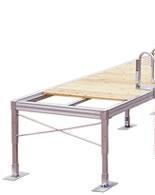
Sway Brace
Does every set of legs need sway braces?
No. PWS will make recommendations based on the heights and lengths of your dock or pier. Often, we add a single brace on a pair of legs. Next, we alternate the position in the opposite direction on the next set of legs.
One brace is attached near the bottom of one leg and clamped higher up on the opposite leg. This depends on the height of the legs.
It may involve a crew member having to submerge in the water to reach the bottom of the leg. In spring, that is not something anyone wants to do.
Does it matter if I have an aluminum or steel frame?
A steel frame is less likely to need braces than an aluminum frame due to its own weight. Different configurations are available for aluminum frames, but the principle is the same.
Braces are available for new installations, as shown here. There is an add-on version (independent components) for existing frames. They can be added to existing dock legs if needed. Either version will help stabilize your dock in deeper water.
Will sway braces help your dock?
Call Jerry at 920-493-4404 for more details.
Where is Pier & Waterfront Solutions?
Located at 7325 St. Hwy 57, it’s 3 miles south of Sturgeon Bay and 1 mile past the intersection of Cty MM (heading north). Look on the right side, one mile north, at the next corner (Idlewild Road and Hwy 57).
Is PWS OPEN?
Pier & Waterfront Solutions remains “open.” We have implemented measures to help ensure the safety of our employees and visitors. PWS continues to work to maintain the trusted service that you have come to expect.
PWS implemented these preventive measures:
1. Conducting as much business as possible by email, text, or phone.
2. Site visits will continue. When in-person contacts are necessary, we will follow “social distancing” guidelines.
3. Our display yard is always open for you to examine at your leisure. All displays have a numbered, red tag on them. If you want more information or pricing, please reference that number.
What can YOU do to help us?
1. Please conduct as much business as possible via emails, messaging, and emails. This step protects everyone involved.
2. When you see our crews installing equipment, please practice “social distancing.” Remain at a safe distance.
Thank you for allowing us to work with you.
YES – PWS is OPEN and waiting for you!
Please call, message, or email PWS with any questions.
Let’s all stay safe!
Aug 10, 2021
WHAT CAUSES SHORELINE EROSION?
Lakeshores are areas of constant dynamic energy. Powerful waves, high water, and ice move soil particles away from shorelines. In more severe cases, small pebbles and eventually rocks begin to wash out. When the water reaches far enough up the shoreline, erosion of lawns and exposing tree roots start.
We’ll try to answer some of your questions today.
What are the leading causes of shoreline erosion?
On open water like Green Bay, the three leading causes of erosions are:
-
- Wave action;
- High water; and
- Ice movement.
The ice on frozen lakes or the Bay can expand towards the shore with a force of many tons per square foot. The ice will destroy most obstacles in its path. Masses of ice put in motion by winds can push trees or buildings over, as exhibited here.
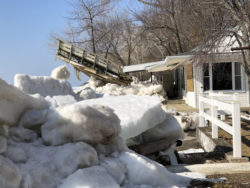
Ice vs deck erosion
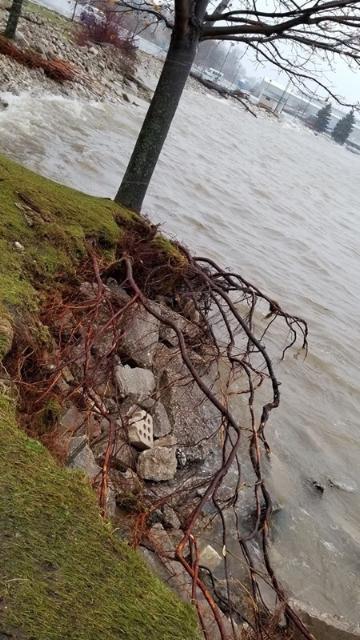
Shoreline tree roots exposed
Ice also pushes embankments, uprooting trees and lawns on small inland lakes. No matter how massive a tree is, the ice won’t slow down for it.
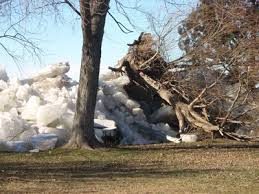
Ice Shove uprooting trees
In relatively small inland lakes, breaking waves can erode lawns away.
Headlands (points) usually have relatively high erosion rates. The waves, currents, and the ice will attack from all three sides. These attacks eventually transport the sediments to a new location where they settle in calmer weather.
Erosion is a normal process of nature.
Erosion and the redistribution of sediments is a natural process along shorelines. Typically, natural erosion proceeds very slowly. The plants and animals that live along the shore can adjust to these slow changes. They maintain a stable, healthy, productive ecosystem.
Accelerated erosion results when natural or human disturbances cause this equilibrium to be upset. Examples of this are higher than normal water levels and intense storms.
Human disturbances include vegetation removal, dredging, filling, or construction near the shoreline.
Another example of natural disturbances is large trees uprooted by a windstorm or a flood. When the soil becomes saturated with water, it weakens the soil around tree roots. The winds may uproot that tree.
IDENTIFY SERIOUS EROSION PROBLEMS
These are several signs of severe erosion problems. (Number one and three are significant)
- A large area of bare soil on a steep, high shoreline bank;
- A measurable change of the shoreline over time;
- Leaning or downed trees with exposed roots; and
- Large patches of muddy water near a lakeshore during periods of high water or following a rainstorm.
3 TYPES OF REACTIVE EROSION CONTROL METHODS:
Vegetative/No Mow: This method involves encouraging or planting trees or woody shrubs for the soil binding properties of their root systems. Grass and other plants will protect against raindrop impact and scouring from surface runoff.
Structural: This includes protective structures. The placement of rock of various sizes (rip-rap) has traditionally been the most effective and least expensive method.
Other structural methods include bulkheads, gabions (rock-filled baskets), and railroad ties. However, these methods are visually unappealing. They require more heavy equipment and technical expertise. These systems are more prone to failure than simple rip-rap. In addition, the DNR has disapproved of these methods in the past.
Manipulative: Mostly used on streams, this includes:
-
-
- Removing streamflow obstructions;
- Grading shoreline banks, or, in exceptional circumstances;
- Rerouting a stream channel.
Are there new techniques developed to prevent erosion?
A new soil preservation method called bioengineering has been proven successful.
Soil bioengineering combines mechanical, biological, and ecological concepts. These methods arrest and prevent shoreline erosion. An example is planting willows interspersed with rip-rap, where the rock provides immediate resistance to decay.
As the willows become established, roots invade and permeate the rock and underlying soil. They bind them together into an erosion-resistant mass. The willows also impart a more “natural” look to the shoreline.
Water levels are down; I don’t have to worry – Right??
This year, people do see water levels about 18-24″ less than in 2020. High water levels are the most significant contributing factor to shoreline erosion.
Will it stay down next year or in the years after? No one knows. In Las Vegas, that’s called a crapshoot.
What other factors affect my shoreline?
The next factor is the intensity of the storms. The Door County Peninsula had numerous high wind storms this year with up to 70 MPH winds.
A popular Marina in Sturgeon Bay: Skipper Bud’s Harbor Marina, located at the foot of the Michigan St. bridge, was a victim of a recent storm.
The marina had two of its five floating docks torn loose during a strong storm. Two tub boats quickly moved in place to prevent them from swinging into the bridge.
Are there other contributing factors to shoreline erosion?
You can expect water levels to rise rapidly when winds blow from the NW – NE direction for prolonged periods. This is despite the lower water levels this year. The stronger the winds, the higher the water will go. Waters south of Sturgeon Bay are particularly affected by these winds. In those areas, there are no other large outlets for the water to escape.
DO YOU NEED AN ESTIMATE FOR RIP-RAP?
Contact Dave@ 920-493-4406 or email at Dave@wisconsinpws.com.
What comes next?
Next week (on Aug 10, 2021), we will cover:
-
-
-
-
- Planning an erosion control project;
- Does erosion hurt my property values?
- What to expect for the cost of rip-rap.
Where is Pier & Waterfront Solutions?
Located at 7325 St. Hwy 57, it’s 3 miles south of Sturgeon Bay and 1 mile past the intersection of Cty MM (heading north). Look on the right side, one mile north, at the next corner (Idlewild Road and Hwy 57).
Is PWS OPEN?
The “Delta” variant is currently surging across the country.
Pier & Waterfront Solutions remains “open.” We have implemented measures to help protect the safety of our employees and visitors. PWS continues to work to maintain the trusted service that you have come to expect.
PWS implemented these preventive measures:
- Conducting as much business as possible by email, text, or phone.
- Site visits will continue.
- When in-person contacts are necessary, we follow “social distancing” guidelines.
- Our display yard is always open for you to examine at your leisure.
- All displays have a numbered, red tag on them. For more information, please reference that number.
What can YOU do to help us?
1. Conduct as much business as possible via emails, messaging, and emails.
2. When you see our crews installing equipment, please practice “social distancing.”
Thank you for allowing us to work with you.
YES – PWS is OPEN and waiting for you!
Please call, message, or email PWS with any questions.
Let’s all stay safe!
Aug 5, 2021
Thanks so much Jerry. Your Customer Service is unparalleled!
Carter R. Door County
Jun 1, 2021
Choice –by any name = Pier & Waterfront Solutions
Pier & Waterfront Solutions offers more dock choices than any Door County dock dealer. Most dealers offer a limited choice of aluminum docks or possibly a lightweight steel dock. Aluminum is popular because it is lightweight and easier to handle. But are they always the best choice for you?
Let’s look at the overall picture.
Pier & Waterfront Solutions is your exclusive ShoreMaster dealer on the Door County peninsula. ShoreMaster offers (5) aluminum dock frame styles. These include configurations for roll-in, stationary, and floating docks.
Now that’s a selection worth investigating!
In general, all ShoreMaster docks are made from the heaviest aluminum materials. In fact, they are almost twice as heavy as other brands. ShoreMaster dock frames are the strongest aluminum frames made. That’s why they hold up so well on the Bay. They are unmatched in quality and have a 15-year structural warranty.
Here is a comparison of the dock choices PWS offers and why they are so popular:
RS 4 –
ShoreMaster RS4 features a 4″ side rail, 10′ and 12′ lengths. There are seven types of decking available. You can use 5-sided aluminum or round steel legs. It’s ideal for calm waters on an inland lake or a sheltered area on the Bay.
RS 4 Curved –
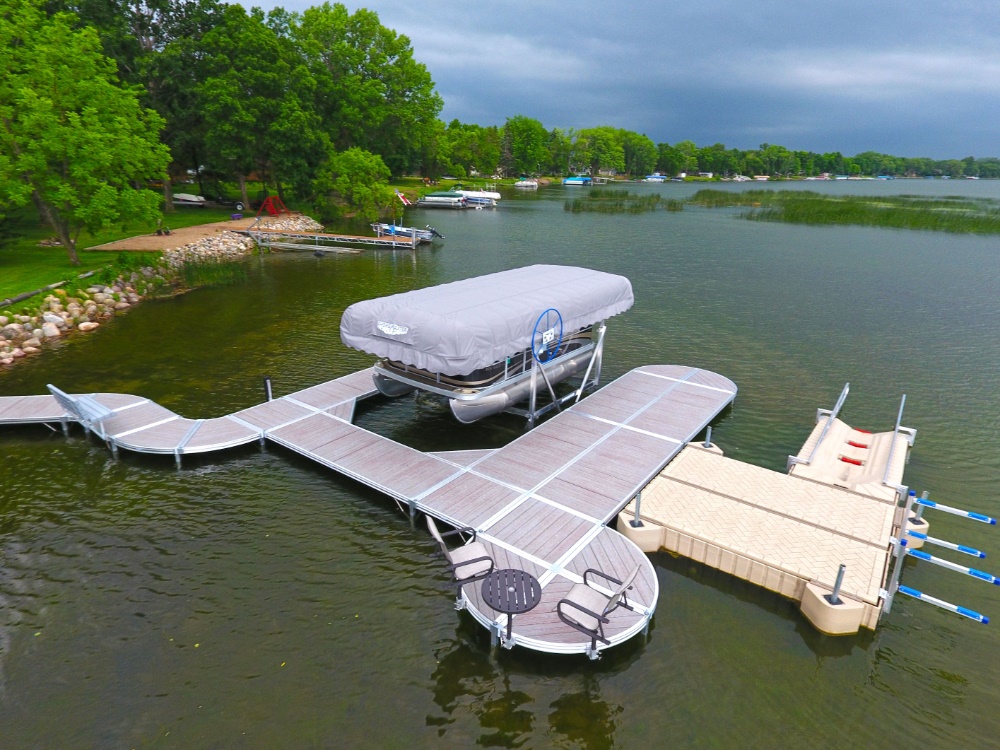
RS4 Curved dock
The RS4 Curved dock is built to the same rigorous specs as the RS 4 shown above. What’s different is the availability of 45 – degree and 90 – degree curved sections.
These curved sections allow for more configurations than anyone else offers. (Hint – You can use curved sections with ANY ShoreMaster dock frame to genuinely make your dock unique.
RS7*
Features a 7″ side rail system. Available in 8′ and 16′ sections. Ideal for rough waters in an open area.
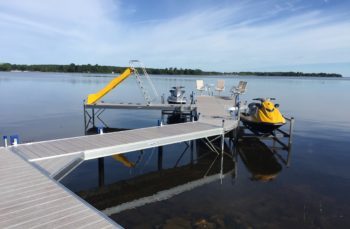
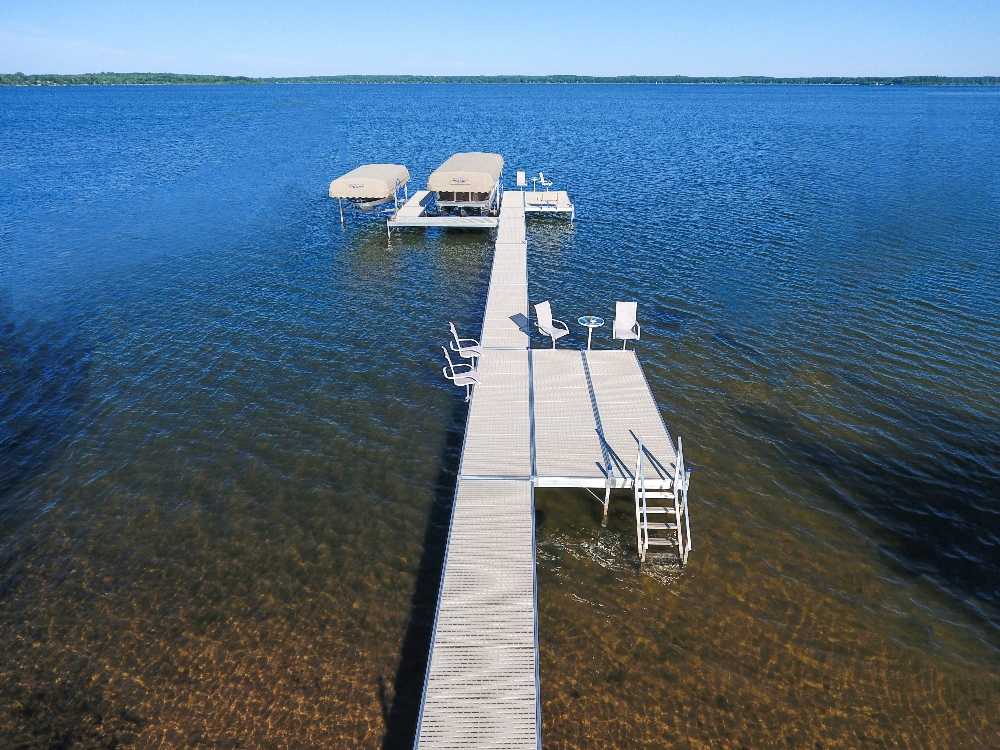
ShoreMaster RS7 and RS4 curved dock RS7 Dock
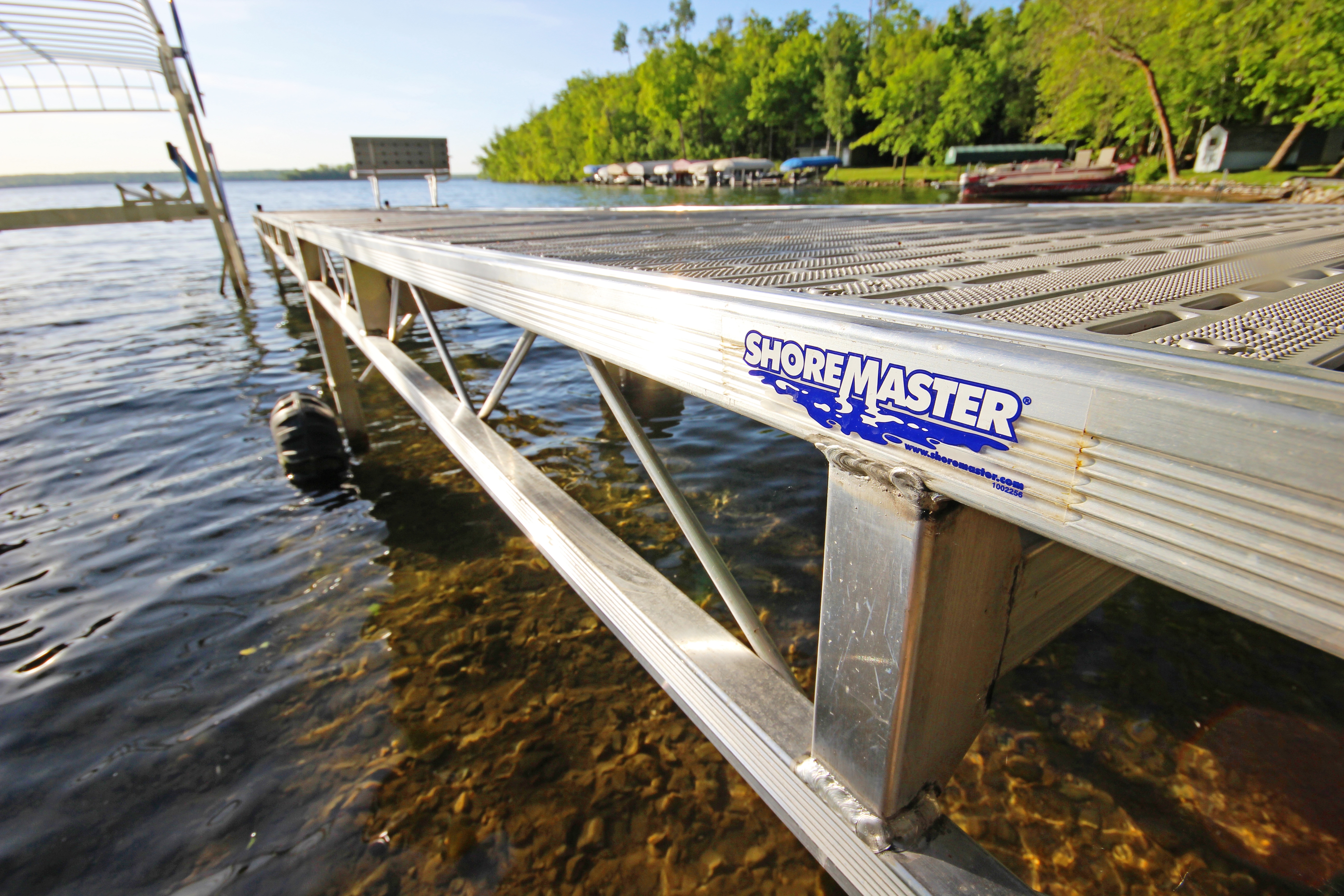
TS9 Dock frame with Flow -Through decking
TS9*
Uses a 9″ Truss construction side frame. 8′ and 16′ sections are available. Use with 5-sided aluminum legs or steel legs— ideal for rough waters and most open areas.
FTS9 –
The FTS9 has the identical construction of the TS9 in all respects. The frames have floats attached and are ideal for soft muddy bottoms.
Even MORE Choices
There are nine different types of decking available for the ShoreMaster frames shown above.

Poly Dock – http://polydockproducts.com/
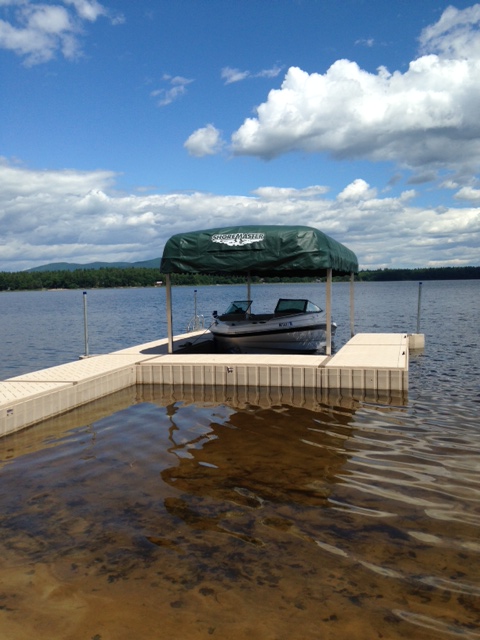
PolyDock floating dock
Poly Dock is a modular dock design made of rotationally molded polyethylene. This floating dock does not have the unsightly black floats.
Poly Dock is a floating dock system that can withstand up to 2′ waves. It’s ideal for inland lakes or rivers with muddy bottoms and large water fluctuations.
Is aluminum the best choice on the Bay?
Aluminum dock frames may not always be the best dock solution with the current high water and heavy storms. Even though water levels are down this year, they are still above average by 14″.
Is there another choice?
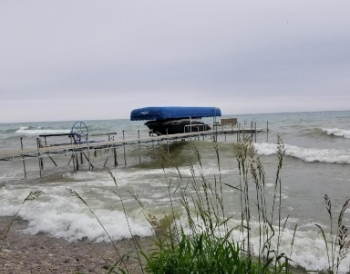
3-Seasons Pier on Lake Michigan
PWS now offers the Exclusive all galvanized steel 3-Season Pier.
The 3-Season Pier meets PWS‘s demanding specifications for strength and durability. It’s a one-of-a-kind dock.
The frames weigh over a quarter ton without the oversized steel legs and decking. 3-Season piers withstand just about everything Mother Nature can throw at it. No Wisconsin manufacturer builds a heavier frame.
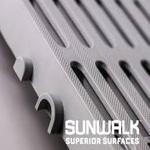
Gray Decking
Speaking of decking, PWS recommends flow-through decking for the 3- Season pier. This type of decking relieves most of the upward pressure caused by a storm’s high waves.
Is the 3 – Season Pier just another steel dock?
PWS was not willing to build just any steel dock. It had to meet their strict standards – or – PWS would not put their name on it. It is our fastest growing product.
Who installs the 3-Season Pier?
PWS installs everything we offer. Our unique ATF’s and the 40′ barge with the 60′ crane make the job look easy.
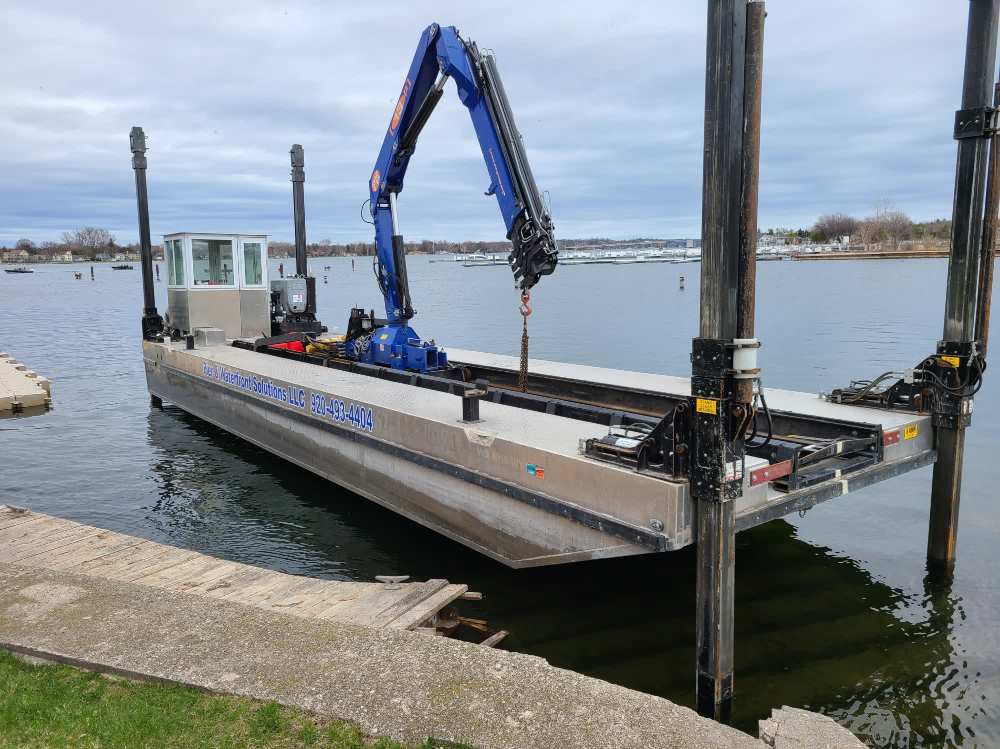
Now you know why Pier & Waterfront Solutions is so popular. We offer everything you need for your dock or lift.
Contact us TODAY!
To Summarize
Pier & Waterfront Solutions has the most dock choices from any manufacturer.
Where can you find Pier & Waterfront Solutions?
Pier & Waterfront Solutions, 7325 St. Hwy 57, is located 3 miles south of Sturgeon Bay. Go 1 mile PAST the intersection with County MM (heading north). Look on the right at the intersection of Idlewild Road and Hwy 57.
PWS is

Pier & Waterfront Solutions remains “open” year-round.
The Covid-19 virus is beginning to wane. We can only hope people will continue to get the vaccine to help slow this illness. We continue to conduct as much business as possible by email, text, or phone.
Site visits continue as usual. When making in-person contacts, we follow “social distancing” guidelines when possible.
PWS display yard – OPEN 24-7
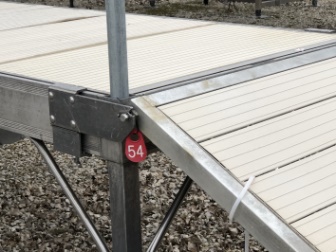
Red Tag
PWS‘s display area is always open for you to examine at your leisure. All displays available for sale have a numbered, red tag on them. Want more information on something you saw in our yard? Please reference that number when you inquire.
PWS provides estimates by email to make the process faster, safer, and paperless.
Call, message, or email Jerry with any questions.
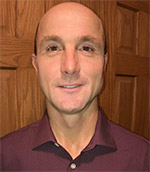
Jerry Englebert
Contact Jerry at 920-493-4404 for more information or use this link.





















